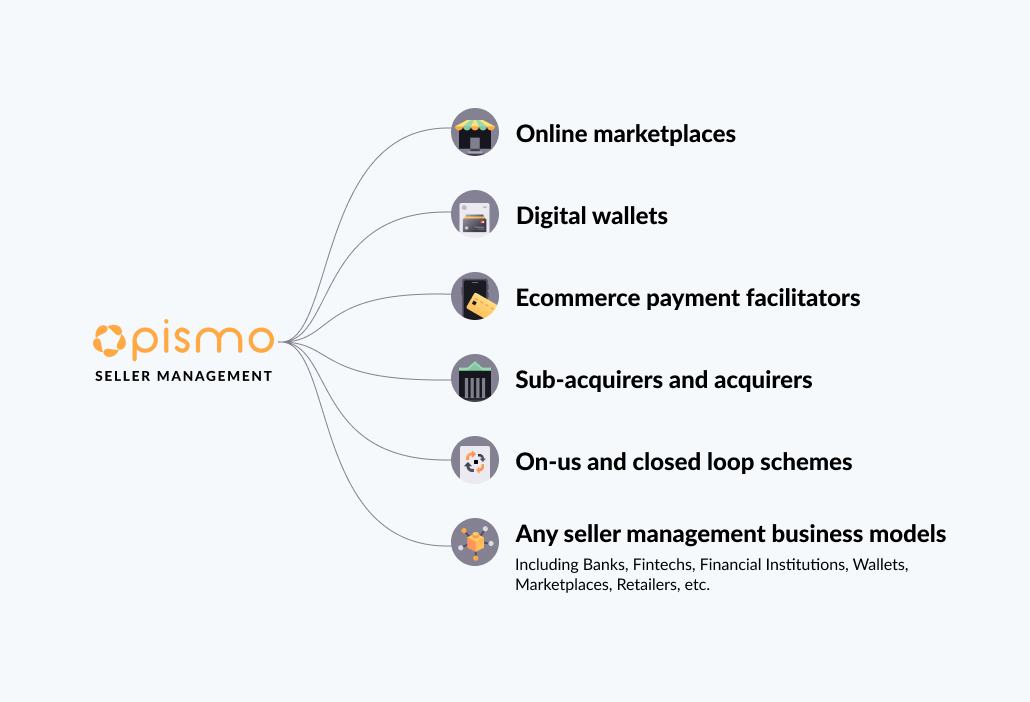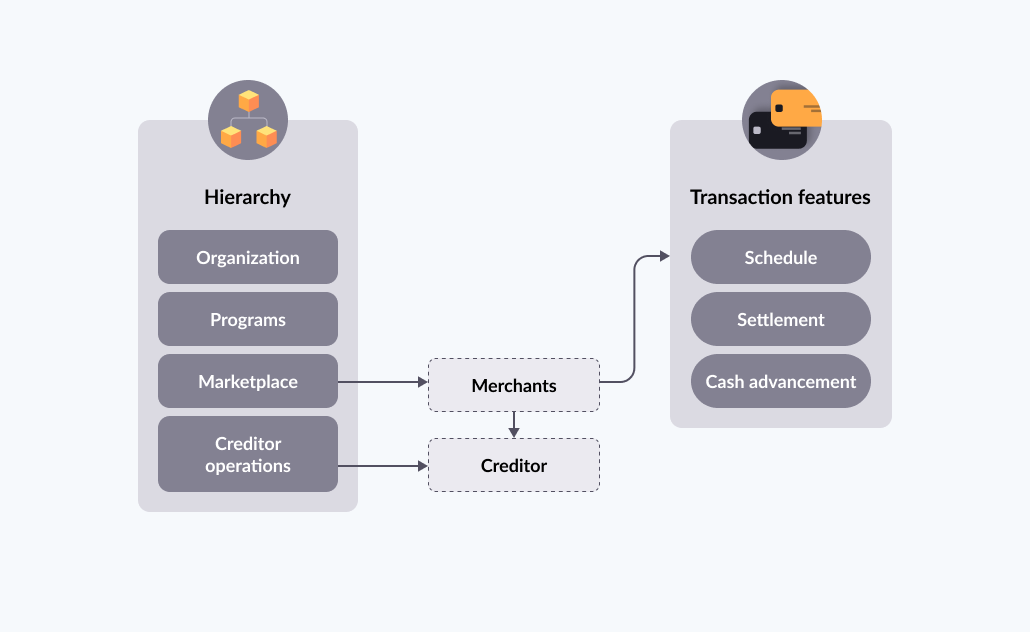Seller management overview
Pismo Seller management provides a complete solution for managing merchants that sell products through online channels and at physical points of sale. Any business that has sellers to manage can use the Seller management platform. This includes merchant banks, fintechs, marketplaces, and payment facilitators.
When planning and implementing your seller marketplace, refer to Seller management onboarding and Get started with seller management. To use Seller management in Control Center, your user role must have Seller management admin assigned in Permissions. Read on for a conceptual overview of seller management and to understand the data models in use.
There are two main concepts in Seller management:
- Marketplace – A grouping of merchants who sell their products online or at physical points of sale. The marketplace discounts a fee from the sales.
- Merchant – An individual or business that sells products or services in the marketplace.
The platform can manage any type of transaction, including card network transactions (off-us and open loop), card transactions without card network (on-us), transfers between two accounts in the same institution (closed loop), and transfers between different institutions through Instant Payments.

Pismo Seller management provides a solution for every aspect of seller management. The platform can manage:
- Marketplaces – A marketplace can have one or more sellers.
- Merchants – A merchant can be linked to one or more marketplaces.
- Merchant accounts – The merchant account is the account that receives the funds from sales. Merchant accounts are called creditor accounts in Seller management and are linked to Creditor objects.
- Rates and fees – Charges that the merchant incurs on sales. In Seller management, these are configured inside the marketplace creditor operation object. They may be different for each transaction type.
- Settlement – The process by which a transaction is finalized and the platform transfers the funds into the merchant’s account. The settlement can be made into an account inside Pismo (internal transfer) or outside Pismo (external transfer).
- Schedules – Seller management can configure when settlement occurs, such as 2 days after the sale, 30 days after the sale, or even the same day as the sale.
- Advancements – A merchant can request a cash advancement (anticipation) before the programmed date. An additional rate or fee is charged for this.

Some benefits of Pismo Seller management:
- Manage vendors and buyers on the same platform. Seller management itself only manages vendors, but you can use other Pismo services, like Accounts and Core Banking to manage buyers.
- Control every aspect of settlement, from authorization to payment. For example, settlements can be internal to Pismo or external with account identifiers.
- Use any payment scheme. Pismo provides management tools that enable you to operate with any payment scheme, from card network to closed loop.
- Create innovative receivables schedules. You can use Seller management to create receivable schedules, mainly using creditor operations that set conditions for each type of transaction. You define the days to pay for each creditor operation. In addition, you can set fine-grained merchant discount rates (MDRs) and other fees, based on transaction type, network, and other factors.
- Handle transactions from on-us and off-us merchants. You can do any type of transaction without restrictions, including on-us and off-us. You might need this to use other Pismo services like cards services for off-us and payment services for on-us; or you can authorize transactions on your side and just send the authorized transactions to the Pismo platform.
Basic object structure
This section explains the main objects that make up your digital marketplace.
Organization (Org)
The Org object defines your company or enterprise. It contains one or more programs. For more information, see Organization.
Program
The Program object normally defines a set of parameters for credit, debit, or pre-paid accounts. In the context of Seller management, it defines parameters for a special type of account called a marketplace account. For more information, see Program types and parameters.
Marketplace
The Marketplace object is the top entity in the hierarchy of objects that make up your digital marketplace. You create a Marketplace object and customize it to suit your business needs. It can represent a single merchant or a group of merchants that share the same tax structure and setup. It also enables you to set up a schedule to handle settlements for all the merchants that belong to the Marketplace.
Use the Create marketplace endpoint to set up a new marketplace.
Merchant
The Merchant object represents a business that sells products or services in your marketplace. It can be anything from a gas station to an e-commerce seller inside a portal. Each merchant has a schedule and a register of transactions in the Marketplace object.
Use the Create merchant endpoint to create merchants. Then use Link merchant to marketplace to add them to your marketplace.
Creditor
The Creditor object represents the owner of a business. It’s associated with a Merchant object and includes a bank object, which is the merchant account. For example, a creditor could be the owner of a gas station. The owner provides Pismo with the merchant account information for the business. This account receives the money from sales during the settlement process.
You create the creditor at the same time you create the merchant, using the Create merchant endpoint.
It’s possible to create a Creditor object using the “Create a creditor” endpoint. However, a creditor created in this way will not have an account associated with it, so Pismo strongly recommends using the Create merchant endpoint instead.
Marketplace creditor operation
For each sale, the merchant must pay a fee and/or rate to the marketplace. This is called the Merchant Discount Rate (MDR). The Marketplace creditor operation object enables the creditor to configure the MDR, the sales rates, and any other fees the merchant is required to pay.
To create a new creditor operation, use the Create creditor operation endpoint. Pass the ID of the merchant that you want to associate with the Creditor operation in the merchant_id field; pass the marketplace ID in the marketplace_id field; and pass the creditor ID in the creditor_id field.
It’s possible to create multiple creditor operations for a creditor and its associated merchant. Each creditor operation can have different values for rates, fees, and days to pay, and these can vary for each type of transaction defined by the client. For example, you can have transactions with and without installments, with and without interest, and so on.
A Merchant object can be linked to only one Creditor object, but a Creditor object can be linked to more than one Merchant object.
Updated 2 months ago